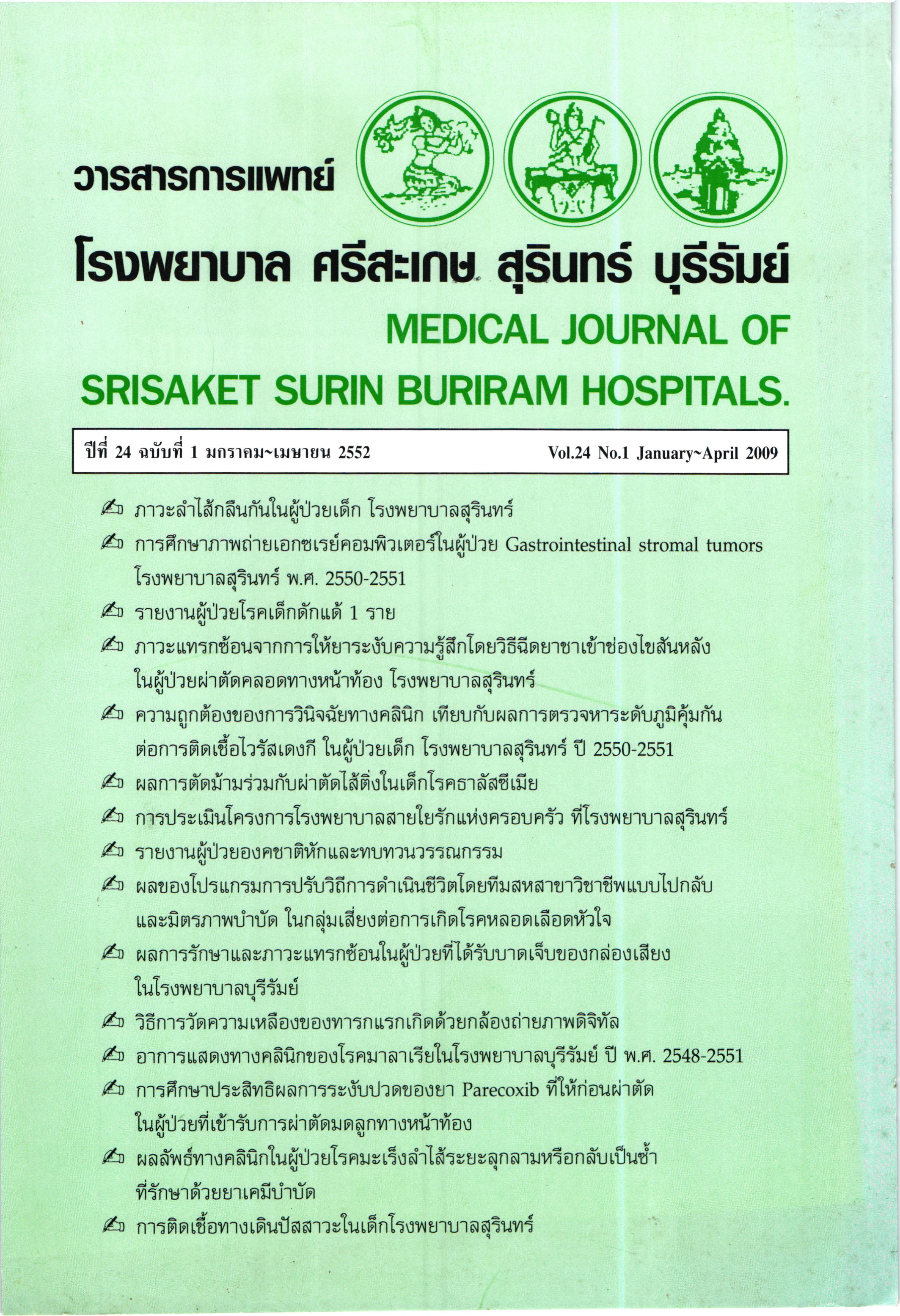การให้ยา ondansetron เพื่อป้องกันอาการคันจากการให้ยา morphine เข้าซ่องน้ำไขสันหลังในผู้ป่วยผ่าตัดคลอด
Main Article Content
บทคัดย่อ
บทนำ: การให้ยามอร์ฟีนเข้าช่องน้ำไขสันหลังให้ผลระงับปวดหลังผ่าตัดได้ดี แต่ ผลข้างเคียง ที่พบบ่อยที่สุด คือ อาการคัน โดยเฉพาะผู้ป่วยที่มารับการผ่าตัดคลอดที่ได้รับยา มอร์ฟีนทางช่องน้ำไขสันหลัง
วัตถุประสงค์: เพื่อศึกษาประสิทธิภาพของยา ondansetron เพื่อป้องกันอาการคันจากการได้รับยาชาผสมกับมอร์ฟีน ในผู้ป่วยที่มารับการผ่าตัดคลอด
วิธีการศึกษา: ทำการศึกษาแบบ Randomized controlled trial ในผู้ป่วยหญิงตั้งครรภ์ครบกำหนด อายุระหว่าง 15-45 ปี ASA physical status I II ที่มารับการผ่าตัดคลอดที่ โรงพยาบาลสุรินทร์ จำนวน 90 คน ผู้ป่วยทุกรายจะได้รับการระงับความรู้สึกโดย การฉีดยาชา 0.5% hyperbaric bupivacaine 2 มล. ผสมกับ morphine 0.2 มก. เข้าช่องน้ำไขสันหลัง หลังจากทารกคลอดและตัดสายละดือแล้ว แบ่งผู้ป่วยออกเป็น 3 กลุ่ม
กลุ่มที่ 1 ได้รับ normal saline 4 มล. ทางหลอดเลือดดำ
กลุ่มที่ 2 ได้รับยา ondansetron 4 มก.ทางหลอดเลือดดำ
กลุ่มที่ 3 ได้รับยา ondansetron 8มก.ทางหลอดเลือดดำ
ผู้ป่วยจะได้รับการประเมินระดับการคัน และคลื่นไส้อาเจียน ที่ 2 และ 24 ชั่วโมง หลังผ่าดัด
สถิติ: ANOVA, Kruskal-Wallis’s test และ Mann-Whitney U-test
ผลการศึกษา: ภายหลังผ่าตัด 2 ชั่วโมง กลุ่มที่ได้รับยา ondansetron 4 มก. และ 8 มก. เกิด อาการคันน้อยกว่ากลุ่มควบคุมอย่างมีนัยสำคัญทางสถิติ (46.7%, 30%, และ 60% ตามลำดับ P<0.05) และที่ 24 ชั่วโมงหลังผ่าตัด อุบัติการณ์ของอาการคันใน กลุ่มที่ได้รับยา ondansetron 4 มก. และ 8 มก. น้อยกว่ากลุ่มควบคุม โดยแตกต่างอย่างมีนัยสำคัญ (13.3%, 6.7%, และ 40% ตามสำตับ P<0.05) สำหรับ ภาวะคลื่นไส้อาเจียน พบว่า กลุ่มที่ได้รับยา ondansetron 8 มก. เกิดน้อยกว่ากลุ่ม ควบคุมอย่างมีนัยสำคัญที่ 2 ชั่วโมงหลังผ่าตัด แต่ที่ 24 ชั่วโมงหลังผ่าตัดทั้ง 3 กลุ่ม ไม่มีความแตกต่างกันทางสถิติ
สรุป: ยา ondansetron สามารถป้องกันการเกิดอาการคันในผู้ป่วยผ่าตัดคลอดที่ได้รับการฉีดยา morphine เข้าช่องน้ำไขสันหลังได้
คำสำคัญ: ondansetron, การให้ยา morphine เข้าช่องน้ำไขสันหลัง, อาการคัน
Article Details
เอกสารอ้างอิง
2. Dahl, Jorgan B, Inge S. Intraoperative and postoperative analgesic efficacy and adverse effects of intrathecal opioids in patients undergoing cesarean section with spinal anesthesia. Anesthesiology.1999;91(6):1919-27.
3. Milner AR, Bogod DG, Harwood RJ. Intrathecal administration of morphine for elective cesarean section. A comparison between 0.1 mg and 0.2 mg. Anesthesia 1996;51:871-3.
4. Yeh H, Chen L, Lin C. Prophylactic intravenousondansetron reduces the incidence of intrathecal morphine induced pruritus in patients undergoing cesarean delivery. Anesth Analg 2000;91:172-5.
5. Crighton IM, Hobbs GJ, Reid MF.Ondansetron for the treatment of pruritus after spinal opioids. Anesthesia 1996;51;199-200.
6. Kyriakides K, Hussain SK, Hobbs GJ. Management of opioid-induced pruritus : a role for 5-HT3 antagoinst. BJA 1999;82(3):439-41.
7. Chaney MA. Side effects of intrathecal and epidural opioids . CJA 2000;42(10):891.
8. Borgeat A. Stimemann HR. Ondansetron is effective to treat spinal or epidural morphine-induced pruritus. Anesthesiology1999;90(2):432-6.
9. Brownridge P, Cohen SE, Ward ME. Neural blockade for obstetric and gynecologic surgery.In : Cousin MJ, Bridenbaugh PO, eds. Neural Blockade : in clinical anesthesia and management of pain, 3rd ed. Philadelphia : Lippincott- Raven 1998:557-604.
10. Churaluxananan S, Somboonviboon WK, yokong O, Nimcharoendee K. Ondansetron for treatment of intrathecal morphine induced pruritus after cesarean delivery. RegAnesth Pain Med 2000;25(5):535-9.
11. Churaluxananan S, Somboonviboon W, Narasethakamol A, Promlok P. Nalbuphine versus ondansetron for prevent of intrathecal morphine induced pruritus after cesarean delivery. Anesth Analg 2004;96(6):1789-93.


